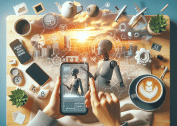As we move further into 2025, artificial intelligence (AI) is poised to fundamentally reshape workplaces, driving unprecedented changes in how businesses operate and employees work. With advancements in machine learning, natural language processing, and robotics, AI is no longer just a tool but a transformative force that enhances productivity, redefines roles, and fosters innovation. While offering immense opportunities, it also presents challenges like workforce adaptation and ethical considerations. This article explores the future of AI and its impact on workplaces, providing practical steps for professionals to thrive in this AI-driven era, without focusing on specific monetary amounts.

Why AI is Shaping the Future of Work in 2025
AI’s rapid evolution is transforming industries by automating tasks, providing data-driven insights, and enabling personalized experiences. In 2025, with hybrid work models, global competition, and digital transformation at their peak, AI is integral to staying competitive. From automating routine processes to augmenting decision-making, AI is redefining job functions and creating new opportunities, making it essential for professionals and businesses to adapt proactively.
Key Ways AI Will Transform Workplaces
AI’s integration into workplaces is driving significant changes, offering both opportunities and challenges. Here’s how it’s reshaping the professional landscape:
1. Automation of Routine Tasks
AI will continue to automate repetitive, low-skill tasks, freeing employees for higher-value work.
- How It Works: Tools like robotic process automation (RPA) and AI chatbots handle data entry, customer inquiries, and scheduling.
- Real-Life Impact: A customer service team uses AI chatbots to handle routine queries, allowing staff to focus on complex issues.
- Tip: Identify repetitive tasks in your role that AI can automate to boost efficiency.
2. Enhanced Decision-Making
AI provides data-driven insights, enabling faster and more accurate business decisions.
- How It Works: AI algorithms analyze vast datasets to predict trends, optimize operations, or personalize customer experiences.
- Real-Life Impact: A marketing manager uses AI analytics to target campaigns, increasing customer engagement.
- Tip: Leverage AI tools like Tableau for data-driven insights in your role.
3. Redefinition of Job Roles
AI will shift job functions, creating hybrid roles that combine technical and human skills.
- How It Works: Roles like AI trainers or ethics specialists emerge, blending creativity, empathy, and technical expertise.
- Real-Life Impact: A traditional HR role evolves into an AI-augmented talent analyst, focusing on strategic hiring.
- Tip: Upskill in AI-related areas to prepare for evolving job demands.
4. Personalized Employee Experiences
AI tailors training, workflows, and support to individual employee needs, boosting engagement.
- How It Works: AI platforms recommend personalized learning paths or optimize schedules based on employee preferences.
- Real-Life Impact: An employee receives AI-curated training modules, enhancing their skills efficiently.
- Tip: Use AI-driven platforms like LinkedIn Learning for tailored professional development.
5. Improved Collaboration in Hybrid Work
AI enhances remote and hybrid work by streamlining communication and collaboration.
- How It Works: AI tools like virtual assistants or transcription software improve meeting efficiency and team coordination.
- Real-Life Impact: A hybrid team uses AI to summarize meetings, ensuring alignment across time zones.
- Tip: Adopt AI collaboration tools like Microsoft Teams with AI features to enhance teamwork.
Challenges of AI in the Workplace
While AI offers transformative benefits, it also poses challenges that must be addressed:
1. Workforce Displacement
Challenge: AI automation may reduce demand for certain roles, requiring reskilling.
- Solution: Learn skills like AI management or data analysis to stay relevant.
- Real-Life Impact: A factory worker transitions to an AI system operator after training.
- Tip: Enroll in courses on Coursera to gain AI-complementary skills.
2. Ethical and Bias Concerns
Challenge: AI systems can perpetuate biases or raise ethical questions if not designed responsibly.
- Solution: Advocate for transparent AI policies and participate in ethics training.
- Real-Life Impact: A company implements AI audits, ensuring fair hiring algorithms.
- Tip: Stay informed about AI ethics through resources like MIT’s AI Ethics course.
3. Integration Complexity
Challenge: Adopting AI can be complex, requiring training and infrastructure changes.
- Solution: Start with user-friendly AI tools and scale adoption gradually.
- Real-Life Impact: A small business uses plug-and-play AI tools to streamline operations without major upfront investment.
- Tip: Pilot AI tools on small projects to build confidence and expertise.
Practical Steps to Thrive in an AI-Driven Workplace
Here’s how professionals can prepare for and leverage AI’s transformation of the workplace:
1. Upskill in AI-Related Skills
Learn skills that complement AI, such as data analysis, AI system management, or programming.
- How to Do It: Enroll in online courses on platforms like Udemy or edX, focusing on Python, AI ethics, or machine learning basics.
- Why It Helps: AI-relevant skills ensure you remain competitive in evolving roles.
- Tip: Dedicate 15–30 minutes weekly to learning one AI-related skill.
2. Embrace AI Tools in Your Workflow
Incorporate AI tools to enhance productivity and demonstrate adaptability.
- How to Do It: Use AI-driven tools like Grammarly for writing, Zapier for automation, or Salesforce for customer management.
- Why It Helps: Familiarity with AI tools showcases tech-savviness and improves efficiency.
- Tip: Experiment with free versions of AI tools to identify those best suited for your role.
3. Stay Informed on AI Trends
Keep up with AI advancements to anticipate changes in your industry.
- How to Do It: Follow AI thought leaders on X or subscribe to newsletters like VentureBeat for updates on AI innovations.
- Why It Helps: Staying informed ensures your skills and strategies align with market demands.
- Tip: Set Google Alerts for “AI in [your industry]” to receive relevant news.
4. Collaborate with AI Experts
Build relationships with AI professionals to gain insights and opportunities.
- How to Do It: Join LinkedIn groups or attend virtual AI conferences to connect with experts and peers.
- Why It Helps: Networking provides knowledge and access to AI-related roles or projects.
- Tip: Engage with one AI expert monthly for advice or collaboration.
5. Advocate for Ethical AI Use
Promote responsible AI adoption in your workplace to address biases and ensure fairness.
- How to Do It: Participate in discussions or training on AI ethics and advocate for transparent AI policies.
- Why It Helps: Ethical AI use builds trust and enhances workplace credibility.
- Tip: Share resources like AI ethics guidelines from IEEE with your team.
6. Review AI Impact Quarterly
Spend 20–30 minutes quarterly assessing how AI tools and skills are enhancing your work.
- How to Do It: Evaluate productivity gains, new skills acquired, or AI-driven project outcomes, adjusting your approach as needed.
- Why It Helps: Regular reviews ensure you maximize AI’s benefits and stay aligned with career goals.
- Tip: Use a tool like Notion to track AI tool usage and skill development progress.
Sample Routine for Thriving in an AI-Driven Workplace
Here’s a routine to integrate AI into your professional life:
- Daily:
- Morning (5 minutes): Check AI tool dashboards (e.g., Zapier) for performance or updates.
- Evening (5 minutes): Reflect on one way AI improved your workday, like automating a task.
- Weekly:
- Sunday (20 minutes): Study an AI-related course module or read an industry article on AI trends.
- Monthly:
- First Sunday (20 minutes): Review AI tool impact on your work and update your resume with new skills.
- Quarterly:
- First Sunday (30 minutes): Assess AI’s role in your industry and plan new skills or tools to adopt.
Tools to Support AI Integration in the Workplace
- AI Platforms: Zapier, UiPath, or Automation Anywhere for workflow automation.
- Learning Resources: Coursera, Udemy, or edX for AI and machine learning courses.
- Collaboration Tools: Microsoft Teams or Slack with AI-driven features for team coordination.
- Networking Platforms: LinkedIn or X for connecting with AI professionals.
- Tracking Apps: Notion or Evernote for monitoring AI skill development and impact.
The Bigger Picture: AI in Workplaces in 2025
In 2025, AI is a transformative force, redefining workplaces by automating tasks, enhancing decisions, and creating new roles. While challenges like displacement and ethics persist, proactive adaptation through upskilling and ethical advocacy ensures professionals thrive. By embracing AI, workers and businesses can unlock innovation and efficiency in a competitive, tech-driven world.
Conclusion: Prepare for an AI-Driven Future
The future of AI promises to transform workplaces by boosting productivity, redefining roles, and fostering innovation. Upskill in AI-related areas, embrace AI tools, and advocate for ethical use, reviewing progress quarterly to stay competitive. In 2025’s AI-driven landscape, these steps position you for success. Start today, and shape your future in an AI-powered workplace.
References:
World Economic Forum. (2025). AI and the Future of Work. https://www.weforum.org/reports/ai-future-work-2025
Forbes. (2025). AI and the Future of Work: What to Expect. https://www.forbes.com/sites/forbesbusinesscouncil/2025/04/15/ai-future-work-what-to-expect/
Harvard Business Review. (2025). How AI is Redefining the Workplace. https://hbr.org/2025/03/how-ai-redefining-workplace
McKinsey & Company. (2025). The Impact of AI on Jobs and Skills. https://www.mckinsey.com/business-functions/operations/our-insights/impact-ai-jobs-skills
TechCrunch. (2025). AI Trends Shaping Workplaces in 2025. https://techcrunch.com/2025/02/ai-trends-workplaces-2025









